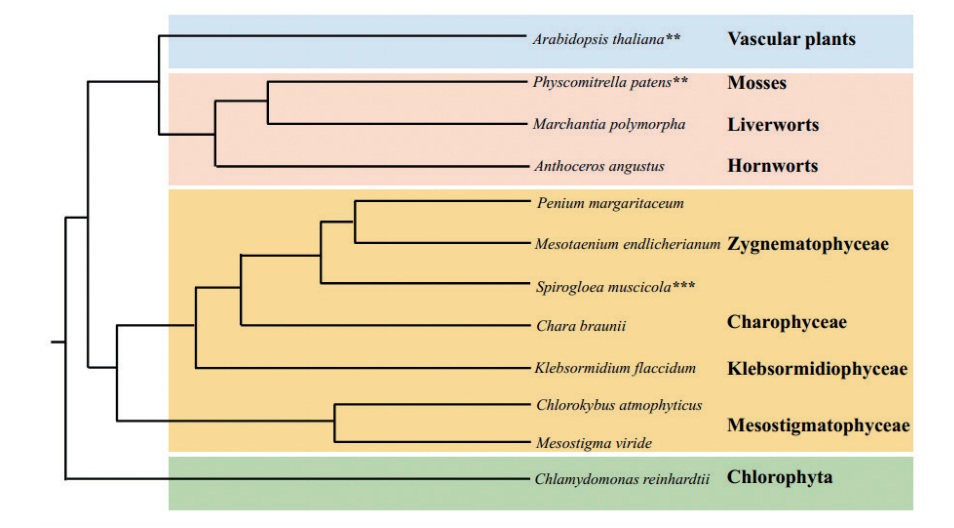

Received date: 2021-04-10
Online published: 2021-06-13

WU Zhen, CHENG Shifeng . Overview on the origin of land plants[J]. Chinese Journal of Nature, 2021 , 43(3) : 225 -231 . DOI: 10.3969/j.issn.0253-9608.2021.03.008
[1] FAZEKAS A J, KUZMINA M L, NEWMASTER S G, et al. DNA barcoding methods for land plants [J]. DNA Barcodes, 2012, 858: 223-252.
[2] BOWLES A M, BECHTOLD U, PAPS J. The origin of land plants is rooted in two bursts of genomic novelty [J]. Current Biology, 2020, 30(3): 530-536.
[3] GAO J. Tracking the evolutionary innovations of plant terrestrialization [J]. Gene, 2020, 769: 145203.
[4] CHENG S, XIAN W, FU Y, et al. Genomes of subaerial Zygnematophyceae provide insights into land plant evolution [J]. Cell, 2019, 179(5): 1057-1067.
[5] DELAUX P M, XIE X, TIMME R E, et al. Origin of strigolactones in the green lineage [J]. New Phytologist, 2012, 195(4): 857-871.
[6] KENRICK P, WELLMAN C H, SCHNEIDER H, et al. A timeline for terrestrialization: Consequences for the carbon cycle in the palaeozoic [J]. Philosophical Transactions of the Royal Society B: Biological Sciences, 2012, 367(1588): 519-536.
[7] KRANNER I, MINIBAYEVA F V, BECKETT R P, et al. What is stress? Concepts, definitions and applications in seed science [J]. New Phytologist, 2010, 188(3): 655-673.
[8] TURMEL M, OTIS C, LEMIEUX C. The mitochondrial genome of chara vulgaris: Insights into the mitochondrial DNA architecture of the last common ancestor of green algae and land plants [J]. The Plant Cell, 2003, 15(8): 1888-1903.
[9] MCCOURT R M, DELWICHE C F, KAROL K G. Charophyte algae and land plant origins [J]. Trends in Ecology & Evolution, 2004, 19(12): 661-666.
[10] NISHIYAMA T, SAKAYAMA H, DE VRIES J, et al. The chara genome: Secondary complexity and implications for plant terrestrialization [J]. Cell, 2018, 174(2): 448-464.
[11] GITZENDANNER M A, SOLTIS P S, WONG G K S, et al. Plastid phylogenomic analysis of green plants: A billion years of evolutionary history [J]. American Journal of Botany, 2018, 105(3): 291-301.
[12] LEEBENS-MACK J H, BARKER M S, CARPENTER E J, et al. One thousand plant transcriptomes and the phylogenomics of green plants [J]. Nature, 2019, 574: 679-685.
[13] RENSING S A. Gene duplication as a driver of plant morphogenetic evolution [J]. Current Opinion in Plant Biology, 2014, 17: 43-48.
[14] SÉMON M, WOLFE K H. Consequences of genome duplication [J]. Current Opinion in Genetics & Development, 2007, 17(6): 505- 512.
[15] RENSING S A. How plants conquered land [J]. Cell, 2020, 181(5): 964-966.
[16] JIAO C, SøRENSEN I, SUN X, et al. The Penium margaritaceum genome: Hallmarks of the origins of land plants [J]. Cell, 2020, 181(5): 1097-1111.
[17] LIU C, WANG C, WANG G, et al. Genome-wide analysis of chromatin packing in Arabidopsis thaliana at single-gene resolution [J]. Genome Research, 2016, 26(8): 1057-1068.
[18] LANG D, ULLRICH K K, MURAT F, et al. The Physcomitrella patens chromosome‐scale assembly reveals moss genome structure and evolution [J]. The Plant Journal, 2018, 93(3): 515-533.
[19] BOWMAN J L, KOHCHI T, YAMATO K T, et al. Insights into land plant evolution garnered from the Marchantia polymorpha genome [J]. Cell, 2017, 171(2): 287-304.
[20] ZHANG J, FU X-X, LI R-Q, et al. The hornwort genome and early land plant evolution [J]. Nature Plants, 2020, 6(2): 107-118.
[21] DURING H J. Life strategies of bryophytes: A preliminary review [J]. Lindbergia, 1979, 5: 2-18.
[22] HORI K, MARUYAMA F, FUJISAWA T, et al. Klebsormidium flaccidum genome reveals primary factors for plant terrestrial adaptation [J]. Nature Communications, 2014, 5(1): 1-9.
[23] WANG S, LI L, LI H, et al. Genomes of early-diverging streptophyte algae shed light on plant terrestrialization [J]. Nature Plants, 2020, 6(2): 95-106.
[24] DÍAZ-SANTOS E, VILA M, VIGARA J, et al. A new approach to express transgenes in microalgae and its use to increase the flocculation ability of Chlamydomonas reinhardtii [J]. Journal of Applied Phycology, 2016, 28(3): 1611-1621.
[25] YONEKURA-SAKAKIBARA K, HIGASHI Y, NAKABAYASHI R. The origin and evolution of plant flavonoid metabolism [J]. Frontiers in Plant Science, 2019, 10: 943.
[26] HARHOLT J, MOESTRUP Ø, ULVSKOV P. Why plants were terrestrial from the beginning [J]. Trends in Plant Science, 2016, 21(2): 96-101.
[27] DOYLE J A. Phylogenetic analyses and morphological innovations in land plants [J]. Annual Plant Reviews, 2013, 45: 1-50. DOI: 10.1002/9781118305881.ch1.
[28] ELSTER J, DEGMA P, KOVÁČIK Ľ, et al. Freezing and desiccation injury resistance in the filamentous green alga Klebsormidium from the antarctic, arctic and slovakia [J]. Biologia, 2008, 63(6): 843-851.
[29] KARSTEN U, HOLZINGER A. Light, temperature, and desiccation effects on photosynthetic activity, and drought-induced ultrastructural changes in the green alga Klebsormidium dissectum (streptophyta) from a high alpine soil crust [J]. Microbial Ecology, 2012, 63(1): 51-63.
[30] NIYOGI K K. Photoprotection revisited: genetic and molecular approaches [J]. Annual Review of Plant Biology, 1999, 50(1): 333- 359.
[31] IFUKU K, ENDO T, SHIKANAI T, et al. Structure of the chloroplast NADH dehydrogenase-like complex: Nomenclature for nuclear-encoded subunits [J]. Plant and Cell Physiology, 2011, 52(9): 1560-1568.
[32] GOUDET M M, ORR D J, MELKONIAN M, et al. Rubisco and carbon‐concentrating mechanism co‐evolution across chlorophyte and streptophyte green algae [J]. New Phytologist, 2020, 227(3): 810-823.
[33] VILLARREAL J C. RENNER S S. Hornwort pyrenoids, carbonconcentrating structures, evolved and were lost at least five times during the last 100 million years [J]. Proceedings of the National Academy of Sciences, 2012, 109(46): 18873-18878.
/
| 〈 |
|
〉 |